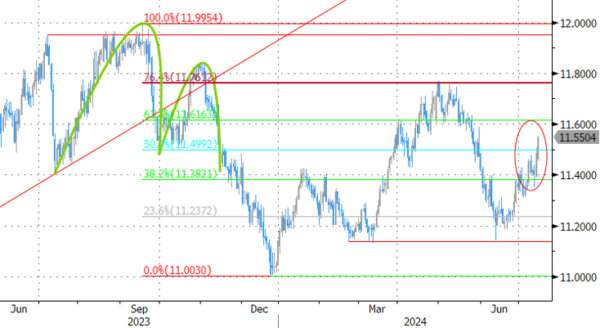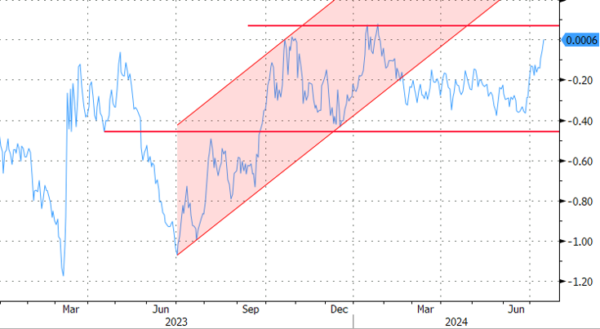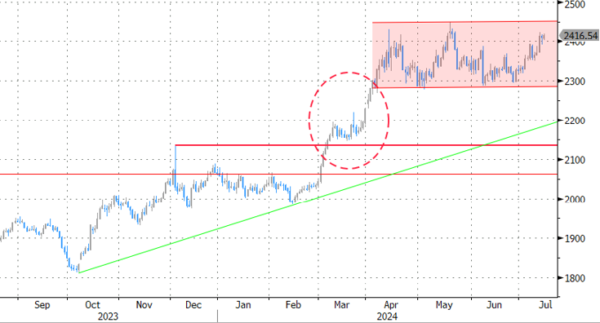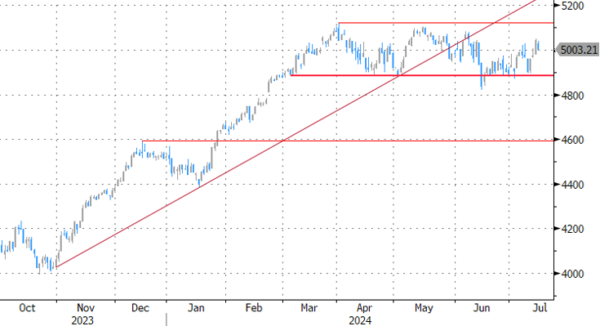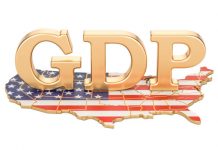Markets
Some segments of the US yield curve disinverted in the wake of the Trump shooting. The presidential candidate’s odds to win the November election have increased as a result. His pro-business (for the US at least) agenda is seen as a boost to the economy as well as increasing already large fiscal deficits. Ex-POTUS amongst others has pledged to extend all (individual, corporate and estate) tax cuts, some of which scheduled to end in 2025. Biden on the other hand would allow tax cuts for the wealthiest to expire and raise the corporate tax rate as well as several others. Today’s bear steepener – dubbed the Trump trade – turned the spread between the US 30-yr (+5.8 bps) and US 2-yr (-0.2 bps) back positive. This wasn’t the case since mid-2022 but for a brief spell in January of this year and in October 2023. German Bunds outperform Treasuries with yield changes varying between -1.5 and -2.2 bps across the curve. Spreads vs Germany’s 10-yr yield narrowed for the likes of Greece, Italy and Portugal. France’s was unchanged. The country’s budgetary watchdog sounded the alarm on the “worrying” state of public finances. Even before the snap elections paved the way for a hung parliament unable to take tough but necessary decisions, Cour des Comptes said president Macron’s updated (in April) program relied on “particularly optimistic” growth projections, “unprecedented” spending cuts and “vague” revenue-boosting measures. Cour des Comptes concluded that the proposed fiscal and debt trajectory “doesn’t seem to be very credible or very realistic”. French stock markets underperform European peers slightly (CAC40 -1.1% vs EuroStoxx50 -0.9%). Wall Street opens with gains of about 0.5%.
The dollar doesn’t stand to benefit from UST underperformance. EUR/USD extends an end-of-June bull run further north of 1.09. Resistance at 1.1916 (early June high) was tested but survives for now. The trade-weighted dollar index’s mirror support is located around 104, which currently serves as the neckline of a double top formation. USD/JPY stabilizes near the recent lows just above 158. The Bank of Japan is suspected of having intervened in FX markets on Friday, capitalizing on a dollar-triggered (US CPI) downleg in USD/JPY. Scandinavian currencies including the SEK and NOK (see below) underperform G10 peers today.
News & Views
The Swedish krone (EUR/SEK 11.52) and the Norwegian krone (EUR/NOK 11.73) continue to fight an uphill battle, suffering additional selling pressure after a setback during the the second half of last week. Both countries last week reported softer than expected June CPI data. Norwegian headline inflation unexpectedly slowed to 0.2% M/M and 2.6% Y/Y and also core inflation slowed to 0.2% M/M and 3.4% (was 4.1% in May). Markets apparently concluded that this might change the view of the Norges Bank (NB) of unchanged policy rates (4.5%) through the end of this year. The Norwegian 2-y swap rate since Wednesday morning dropped almost 30 bps. A similar story is developing for the Swedish krone. Headline inflation in the country in June slowed more than expected (-0.1% M/M and 2.6% y/y). The preferred measure of the Riksbank (CPIF inflation with a fixed interest rate) even dropped further below the 2.0% target (0.0% M/M and 1.3% Y/Y). The RB was already a frontrunner by reducing the policy rate by 25bps in May. It indicated in June that two or three cuts might follow in the second half of the year. Markets now fully discount three additional 25 bps steps with the first one seen at the upcoming meeting in August.
According to a Reuters coverage of comments by Spanish Economy Minister Carlos Cuerpo in a newspaper interview with El Pais this weekend, the government expects a better than expected performance of the economy in the first half of the year to result in a higher growth forecast for this and next year. The economy performed better than expected in the first half of this year, considering strong employment data, investment and tourism. Cuerpo now expects economic growth at 2.4% this year and 2.2% in 2025. The government initially assumed 2.0% growth this year and 1.9% in 2025, but already suggested an upward revision. Spain recorded a strong 0.8% growth in Q1 of this year. Cuerpo also sees better than expected growth to contribute to the budget deficit declining to 3.0% of GDP this year and even below that EU reference next year. This process should bring the government debt-to-GDP ratio below 100% in 2027.
Graphs
EUR/SEK: Swedish (and Norwegian) krone underperform G10 peers amid softer-than-expected inflation numbers
US 30/2-yr spread turns back positive as Trump trade gains momentum
Gold ($/ounce) caught in a sideways trend channel, nearing the upper bound. Trump shooting leaves immaterial mark
EuroStoxx50 struggles to hold north of recently reconquered 5K barrier




